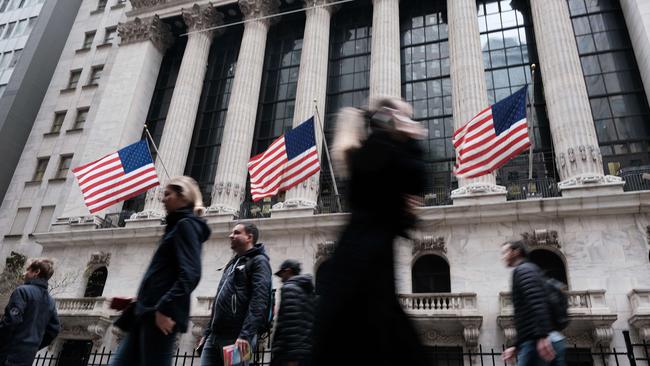Fed approves half-point interest rate rise, ratcheting up its inflation fight
The Federal Reserve approves a half-point interest rate increase and plans to shrink its $US9 trillion bond portfolio.

The Federal Reserve approved a rare half-percentage-point interest rate increase and announced plans to shrink its $US9 trillion asset portfolio starting next month in a double-barrelled effort to reduce inflation that is running at a four-decade high.
The moves, announced after a two-day policy meeting Wednesday, will raise the central bank’s benchmark federal-funds rate to a target range between 0.75 per cent and 1 per cent.
Together, the steps mark the most aggressive Fed tightening of monetary policy at one meeting in decades, aimed at rapidly reducing the economic stimulus that has contributed to rising price pressures. The Fed, which usually lifts interest rates in quarter-percentage-point increments, last raised rates by a half point in 2000.
“Inflation is much too high and we understand the hardship it is causing and we’re moving expeditiously to bring it back down,” Fed Chairman Jerome Powell said at a news conference after the meeting. “We have both the tools we need and the resolve that it will take to restore price stability on behalf of American families and businesses.” The rate-setting Federal Open Market Committee approved the decision unanimously. In a statement, the committee said it “anticipates that ongoing increases in the target range will be appropriate,” setting the stage for another large rate rise at the Fed’s meeting next month.
The statement cited the potential for Covid-related disruptions in China to sow further chaos to global supply chains that could keep inflation elevated. “The Committee is highly attentive to inflation risks,” it said.
Fed officials also finalised plans to start shrinking their mammoth holdings of Treasury and mortgage securities passively– that is, by allowing bonds to mature without reinvesting the proceeds into new securities rather than by selling them in the open market.
Officials will allow up to $US30bn in Treasuries and $US17.5bn in mortgage bonds to roll off every month in June, July and August. After that, they will allow $US60bn in Treasurys and $US35bn in mortgage securities to run off every month.
Officials have estimated that the process could allow up to $US3 trillion in securities to run off the Fed’s portfolio over the next few years. They dramatically increased purchases of securities in March and April 2020– when the pandemic shook the U.S. economy– to stabilise dysfunctional financial markets and then continued to buy assets to provide extra stimulus to the economy.
The Fed’s holdings of mortgage securities and Treasurys have doubled since early 2020 to $US2.7 trillion and nearly $US5.8 trillion, respectively. Officials ended those purchases in March.
Reversing the portfolio expansion serves as an additional way to remove stimulus and lift borrowing costs, though the exact magnitudes of such tightening are difficult for policy makers and economists to quantify.
The questions of greatest interest to investors right now are two fold. The first centres on near-term tactical considerations as Fed officials race to catch up after repeatedly underestimating inflation pressures and the strength of domestic economic demand. Investors are trying to figure out how quickly the Fed might raise rates to a neutral level designed to slow growth, including what it might take for officials to accelerate rate rises to an even-larger 0.75-percentage-point step.
Mr. Powell signalled such a step was highly unlikely barring a dramatic deterioration in the inflation outlook — and that the central bank was instead focused on raising rates in half-point intervals, or 50 basis points, for now. “If we see what we expect to see, then we would have 50 basis point increases on the table for the next two meetings,” Mr. Powell said.
Second, investors are looking for clues about how high the Fed might raise rates. For now, investors expect the Fed to raise rates by the end of next year to around 3.25%.
Between 2004 and 2006, the Fed raised its benchmark rate by 4.25 percentage points to a peak of 5.25 per cent. Between 2015 and 2018, Fed officials raised rates from near zero to a range between 2.25 per cent and 2.5 per cent before Mr Powell signalled an abrupt end at the beginning of 2019.
While short-term interest rates remain at historically low levels, the central bank is signalling a path for rate increases that could be as aggressive as any since the 1980s.
Compared with that period, the Fed now communicates publicly much more about its policy intentions. That jawboning is a big reason why longer-term borrowing costs, such as the 30-year mortgage rate, have jumped sharply since the beginning of the year even though the Fed has raised its benchmark rate only a little bit.
Because long-term interest rates matter most for economic activity — as opposed to the overnight rate that is set directly by the Fed — policy tightening occurs when investors price in future changes so long as the central bank follows through on those expectations.
The upshot is that borrowing costs for home mortgages, auto loans, and business debt could begin to slow economic growth later this year. The average 30-year mortgage rate rose to 5.36 per cent last week, up over 2 percentage points since late last year, the Mortgage Bankers Association said Wednesday. The trade group said applications for mortgages to purchase homes were 11 per cent lower than one week ago.
During the past 80 years, the Fed has never lowered inflation as much as it is setting out to do now — by 4 percentage points — without causing recession. In this case, the central bank will need a number of factors out of its control to break its way.
In March, Fed officials lifted rates for the first time since lowering them to near zero when the pandemic hit two years earlier. Officials’ projections in March suggested they could lift rates at every meeting this year and a few more times next year to around 2.75 per cent — a level estimated to be within a neutral range designed to neither spur nor slow economic growth. They projected that inflation would gradually fall to just above their 2% target in the next three years.
Some economists say the Fed will have to raise rates higher just to maintain a neutral setting because underlying inflation has risen. Consumer prices rose 6.6 per cent in March from a year before — as measured by the Fed’s preferred inflation gauge, the Commerce Department’s personal-consumption expenditures price index — to a new four-decade high. A separate measure derived from that index by the Dallas Fed that excludes the most volatile items to gauge underlying price pressures was up 3.7 per cent in March.
Demand has been stoked by low interest rates and $US6.4 trillion of government borrowing and spending since Covid-19 struck. Businesses and households spent money faster than a pandemic-strained economy could deliver goods and services, so prices soared. The Fed initially believed last year that surging inflation would abate on its own, but Mr Powell pivoted in November amid signs of growing labour-market imbalances.
Fed officials have been banking on inflation diminishing this year as supply chains stop deteriorating, but the war in Ukraine and sanctions against Russia by the West have pushed up prices for food, energy, and commodities. New lockdowns in China threaten to aggravate supply bottlenecks.
Domestic sources of inflation could keep inflation high in the coming months as tighter labour markets and low housing vacancy rates push up wages and rents, two sources of inflation that tend to be more persistent and harder to wring out of the economy without a downturn.
The unemployment rate in March fell to 3.6 per cent, near the half-century lows recorded before the pandemic hit the US. Last week, a Labor Department measure of worker pay showed wages and benefits for private-sector workers continued to rise at its highest rate in two decades.
The Wall Street Journal


